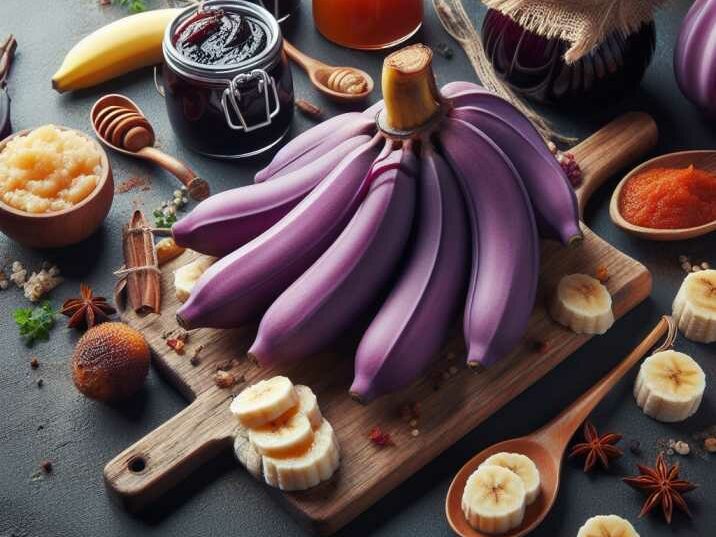Introduction
Table of Contents
7 Astonishing Facts About the Purple Banana
In the vast tapestry of fruits, there exists a mysterious category that captivates both the curious and the gastronomically adventurous. Have you ever wondered about the existence of a purple banana-like fruit? In this exploration, we unravel the secrets behind this peculiar fruit, delving into its origin, properties, and the wonders it holds. Let’s embark on a journey to demystify the enigmatic ‘purple banana-like fruit.

Unveiling the Purple Banana-Like Fruit
The Enchanting Appearance
Imagine a fruit that mirrors the shape of a banana but boasts a vivid purple hue. This captivating visual is the hallmark of the ‘purple banana-like fruit.’ Its unique appearance sparks intrigue and sets it apart from the more conventional fruits we encounter daily.
Origin and Global Presence
The roots of the ‘purple banana-like fruit’ can be traced to tropical regions, where it thrives in warm climates with well-drained soil. While its exact origin remains a subject of debate, this exotic fruit has found its way into various corners of the globe, bringing a touch of mystery to diverse culinary landscapes.
7 Surprising Insights into the Purple Banana-Like Fruit
- Distinctive Flavor Profile : The flavor of the ‘purple banana-like fruit’ is a delightful blend of sweetness with subtle tart undertones. Its unique taste adds an exotic twist to both sweet and savory dishes, making it a sought-after ingredient in culinary experiments.
- Nutritional Powerhouse : Beneath its mesmerizing exterior lies a trove of nutritional benefits. Packed with essential vitamins, minerals, and antioxidants, this fruit contributes to overall well-being. Its nutritional richness makes it a potential addition to a balanced and healthy diet.
- Versatility in Culinary Delights : From jams and desserts to savory dishes, the ‘purple banana-like fruit’ lends itself to a myriad of culinary creations. Its versatility in the kitchen opens up a world of possibilities for chefs and home cooks alike.
- Cultural Significance : In certain cultures, the ‘purple banana-like fruit’ holds cultural significance, often being used in rituals, celebrations, and traditional medicine. Its role extends beyond the realm of food, adding a layer of cultural richness to its narrative.
- Limited Harvest Period : One of the intriguing aspects of this fruit is its limited harvest period. The short window of availability adds an element of exclusivity, making it a seasonal delicacy eagerly anticipated by enthusiasts.
- Botanical Identity : Scientifically classified as Musa violacea, the ‘purple banana-like fruit’ belongs to the same botanical family as the common banana. However, its distinct characteristics set it apart as a unique and fascinating specimen.
- Cultivation Challenges and Conservation Efforts :
Despite its popularity, cultivating the ‘purple banana-like fruit’ comes with challenges. Conservation efforts are underway to ensure the sustainable growth of this exotic fruit, preserving its biodiversity for future generations.
Information
| Fact | Description |
|---|---|
| Appearance | Vibrant purple, banana-like shape |
| Origin | Tropical regions with warm climates |
| Flavor | Sweet with subtle tart undertones |
| Nutritional Benefits | Rich in vitamins, minerals, and antioxidants |
| Culinary Versatility | Suitable for sweet and savory dishes |
| Cultural Significance | Used in rituals, celebrations, and traditional medicine |
| Harvest Period | Limited availability, making it a seasonal delicacy |
Conclusion:
A Culinary Adventure Unveiled
In conclusion, the ‘purple banana-like fruit’ emerges as not just a culinary curiosity but a symbol of biodiversity, cultural significance, and nutritional richness. As we navigate its distinctive flavors and explore its cultural tapestry, the mystery surrounding this exotic fruit adds a touch of magic to our gastronomic journey. Whether you encounter it in a bustling market or incorporate it into your kitchen experiments, the ‘purple banana-like fruit’ invites you to savor the marvels of nature’s palate.
FAQs:
Demystifying the Purple Banana-Like Fruit
- What gives the ‘purple banana-like fruit’ its distinct color? The vibrant purple color is attributed to anthocyanins, natural pigments with antioxidant properties.
- Can I eat the skin of the ‘purple banana-like fruit’? While technically edible, the skin is often tough and bitter. It’s recommended to consume only the flesh.
- Where is the ‘purple banana-like fruit’ most commonly grown? It thrives in tropical regions, with significant cultivation in Southeast Asia, South America, and parts of Africa.
- Is the ‘purple banana-like fruit’ genetically modified? No, the fruit’s unique characteristics are a result of natural cultivation and selective breeding.
- Can I grow the ‘purple banana-like fruit’ at home? Cultivating this fruit at home may be challenging due to its specific climate and soil requirements.
- Are there any known health benefits associated with this fruit? Yes, it is rich in essential nutrients, contributing to overall health and well-being.
- How do you know when the ‘purple banana-like fruit’ is ripe? Ripeness is indicated by a softening of the fruit and a deepening of its purple color.
- Is the ‘purple banana-like fruit’ used in traditional medicine? Yes, in certain cultures, it is believed to have medicinal properties and is used in herbal remedies.
- What recipes commonly feature the ‘purple banana-like fruit’? It is used in jams, desserts, smoothies, and savory dishes, adding a unique flavor to various culinary creations.
- How is the ‘purple banana-like fruit’ different from regular bananas? While they share a botanical family, the ‘purple banana-like fruit’ has a distinct appearance, flavor, and nutritional profile.
- Why is the harvest period of the ‘purple banana-like fruit’ limited? Environmental factors and the fruit’s specific growth requirements contribute to its seasonal availability.
- Are there conservation efforts in place for the ‘purple banana-like fruit’? Yes, initiatives aim to preserve the biodiversity of this unique fruit, ensuring its sustainable cultivation.
